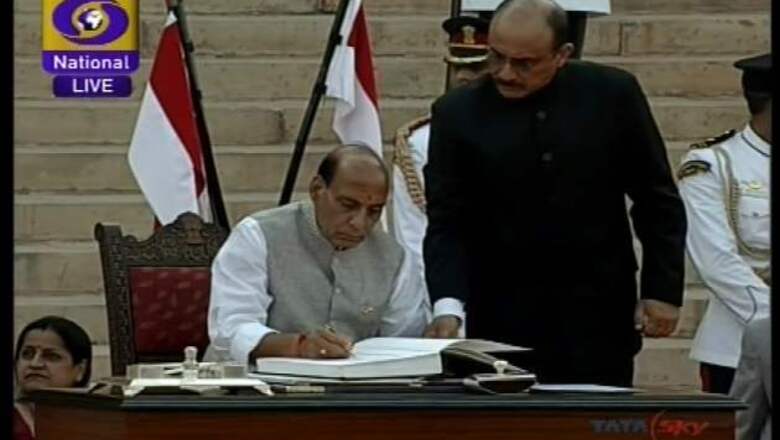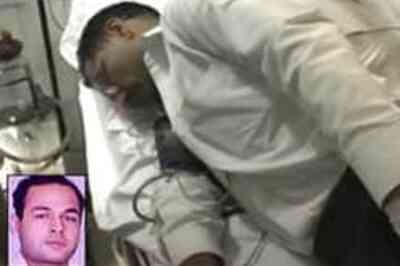
views
Rajnath Singh, the teacher- turned politician, is returning to government in a seamless journey from a party president, under whose stewardship the BJP has returned to power with highest ever tally.
62-year-old Singh, who steadfastly announced Modi's name as BJP's Prime Ministerial candidate despite opposition from seniors like L K Advani, is going to be one of the trusted lieutenants of Prime Minister Modi with a major say in the functioning of the government.
Singh, a two-term BJP president, rose from a BJP activists in Gorakhpur, where he tought physics in a local college, to Chief Minister of politically crucial Uttar Pradesh and then Transport and Agriculture Minister in Atal Bihar Vajpayee government.
His rise in politics has been gradual and steady during which he had been BJP chief from 2006 to 2009 and earned the reputation of being an able administrator as Union Minister and Chief Minister of Uttar Pradesh.
Elected to Lok Sabha from Lucknow, Singh has emerged from the ranks as a political heavyweight in the party largely due to his proximity to BJP's spiritual mentor RSS.
After taking over BJP's reins for the first time from Advani in December 2005, Singh sought to rebuild the party by focusing on basic Hindutva ideologies and said there would be "no compromise" on building the Ram Temple in Ayodhya.
However, he not only failed to steer the party to power in the 2009 general elections but BJP's poll tally dropped by 22 seats compared to 2004 Lok Sabha polls.
Born on July 10, 1951 at Bhabhaura village in Uttar Pradesh's Chandauli district, Singh obtained MSc in physics from Gorakhpur University and was appointed lecturer in the KB Post degree college in Mirzapur in 1971.
Singh's association with Rashtriya Swayamsevak Sangh began in 1964 when he was only 13 year old. Even as lecturer he remained attached to RSS.
Rising step by step, he began his political innings with BJP's student wing Akhil Bharatiya Vidyarthi Parishad (ABVP) in 1969 as its organising secretary in Gorakhpur and rose to become the secretary of the then Bharatiya Jan Sangh's Mirzapur unit in 1974.
During the Emergency, Singh joined Jaiprakash Narayan's movement and was arrested in July 1975 before being released in 1977.
Singh made his debut in electoral politics when he became an MLA in Uttar Pradesh in 1977. In 1983, he became state Secretary of BJP and a year later he found himself leading the Uttar Pradesh unit of BJP's Youth Wing (BJYM).
His political rise continued with his elevation as National General Secretary of BJYM in 1986 and subsequently its National President in 1988.
In the same year, Singh was elected Member, Legislative Council in UP, a position he held till 1994, serving in between as Education Minister in the Kalyan Singh government until it was dismissed in December 1992 following the Babri Masjid demolition.
As Education Minister in UP, Singh had courted controversy by enacting the Anti-Copying Act which had opposition parties up in arms against him.
Although active in UP politics for long, Singh's entry into Parliament came only in 1994 when he was given a Rajya Sabha ticket and also appointed Chief Whip of the BJP in the Upper House.
He was again brought back as party president in UP in 1997 in the wake of turbulence in state politics in 1997 and held the position till 1999 when he was first inducted into Atal Bihari Vajpayee-led NDA government as Surface Transport Minister.
It was under Singh that Vajpayees dream project, National Highway Development Programme was launched. Singh's shuttle between UP and the Centre continued when on October 28, 2000, he was chosen to succeed veteran leader Ram Prakash Gupta as Chief Minister of UP.
Singh remained at the helm till 2002 when the party faced a drubbing at the hands of Samajwadi Party and Bahujan Samaj Party in the state.
After BJP decided to support BSP chief Mayawati as chief minister of UP, a move Singh had opposed, he returned to national politics as BJPs national General Secretary. Soon, Singh, hailing from a farmers family, again found his way back into the Vajpayee cabinet as Agriculture Minister after Ajit Singh parted ways with NDA in 2003.
Singh's journey up BJP hierarchy continued as he became its national President on December 31, 2005. His stint at the party helm saw BJP scoring some high points as it captured power in several states and also installed its first-ever government in Karnataka creating history by hoisting the saffron flag in the South as the ruling party.
He assumed the charge of the party president again in 2013 and continues to hold the charge.
Singh is married with two sons and a daughter.


















Comments
0 comment